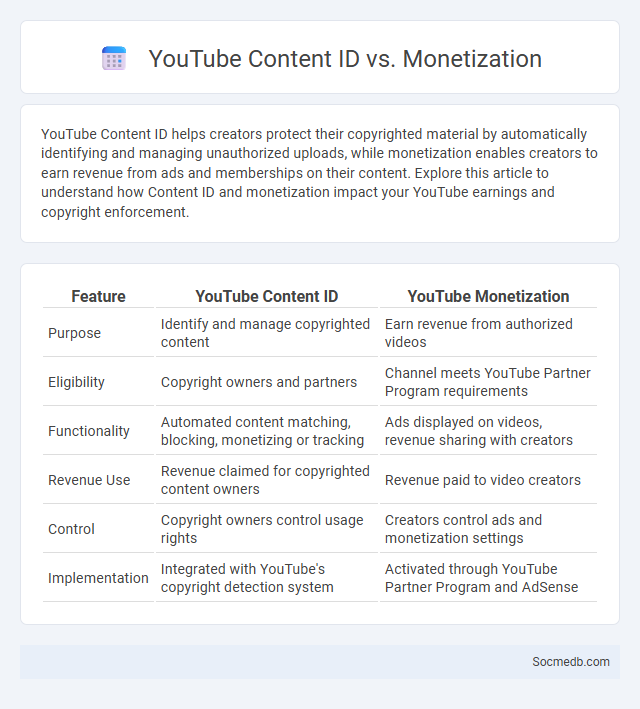
Photo illustration: YouTube Content ID vs Monetization
YouTube Content ID helps creators protect their copyrighted material by automatically identifying and managing unauthorized uploads, while monetization enables creators to earn revenue from ads and memberships on their content. Explore this article to understand how Content ID and monetization impact your YouTube earnings and copyright enforcement.
Table of Comparison
| Feature | YouTube Content ID | YouTube Monetization |
|---|---|---|
| Purpose | Identify and manage copyrighted content | Earn revenue from authorized videos |
| Eligibility | Copyright owners and partners | Channel meets YouTube Partner Program requirements |
| Functionality | Automated content matching, blocking, monetizing or tracking | Ads displayed on videos, revenue sharing with creators |
| Revenue Use | Revenue claimed for copyrighted content owners | Revenue paid to video creators |
| Control | Copyright owners control usage rights | Creators control ads and monetization settings |
| Implementation | Integrated with YouTube's copyright detection system | Activated through YouTube Partner Program and AdSense |
Understanding YouTube Content ID
YouTube Content ID is an advanced digital rights management system designed to help content creators and copyright owners protect their original videos from unauthorized use. By scanning uploaded videos against a database of registered content, the system automatically identifies matches and enables rights holders to monetize, block, or track these videos. Understanding YouTube Content ID is essential for creators to manage their intellectual property effectively and optimize revenue streams on the platform.
What is YouTube Monetization?
YouTube monetization refers to the process through which content creators earn revenue from their videos on the YouTube platform. By enabling ads, channel memberships, Super Chat, or YouTube Premium revenue, creators can generate income based on views, engagement, and subscriber activity. You can optimize your channel and comply with YouTube Partner Program policies to maximize your monetization potential and turn your content into a profitable venture.
How Does Content ID Work?
Content ID works by automatically scanning videos uploaded to platforms like YouTube and comparing them against a database of copyrighted material provided by content owners. When a match is detected, the system can block, monetize, or track the video based on the rights holder's preferences. Your uploads are analyzed to ensure compliance with copyright rules, protecting creators while managing digital rights effectively.
Key Differences: Content ID vs Monetization
Content ID in social media platforms primarily functions as an automated system that identifies and manages copyrighted material, helping creators and rights holders protect their intellectual property. Monetization, on the other hand, involves the processes and tools that enable content creators to earn revenue through ads, subscriptions, or fan support directly within the platform. While Content ID safeguards against unauthorized use, monetization focuses on generating income from approved and original content.
Benefits of YouTube Content ID for Creators
YouTube Content ID empowers creators by automatically identifying and managing copyrighted material, ensuring they receive proper monetization and copyright protection. This system streamlines the process of tracking unauthorized use, allowing creators to focus on producing quality content without manual copyright enforcement. Enhanced revenue opportunities and improved legal control over intellectual property significantly benefit creators through Content ID.
Challenges of Monetization on YouTube
Monetization on YouTube faces significant challenges such as fluctuating ad revenue due to algorithm changes and advertiser preferences, stringent content policies that can demonetize videos, and intense competition among creators for limited advertising dollars. The platform's reliance on ad-based income often forces creators to diversify revenue streams through sponsorships, merchandise, and crowdfunding to achieve financial stability. Navigating copyright claims and ensuring compliance with YouTube's community guidelines are critical to maintaining monetization eligibility over time.
Copyright Claims: Content ID’s Role
Content ID plays a crucial role in managing copyright claims on social media by automatically identifying and resolving unauthorized use of protected content such as music, videos, and images. Your uploaded material is scanned against a vast database of copyrighted works, allowing rights holders to monetize, block, or track matched content efficiently. This system helps maintain compliance with copyright laws while enabling creators to protect their intellectual property on platforms like YouTube and Facebook.
Revenue Sharing: Content ID vs Monetization
Revenue sharing on social media platforms differs significantly between Content ID systems and direct monetization methods. Content ID enables creators to automatically identify and claim royalties from copyrighted material used in user-generated videos, ensuring consistent revenue streams from ads placed by platform owners. Your choice between leveraging Content ID or opting for direct monetization strategies depends on the type of content you produce and your goals for maximizing income while maintaining control over your work.
Managing Disputes in Content ID and Monetization
Effective management of disputes in Content ID and monetization on social media platforms requires precise identification and resolution protocols to protect copyright holders and content creators. Utilizing automated Content ID systems combined with manual review processes ensures accurate claims, minimizes false positives, and facilitates fair revenue distribution. Transparent appeal mechanisms and clear guidelines help resolve conflicts efficiently, maintaining trust and compliance within the digital content ecosystem.
Choosing the Right Approach for Your YouTube Channel
Choosing the right approach for your YouTube channel involves understanding your target audience, content niche, and engagement goals. Tailoring your video style, upload schedule, and SEO tactics ensures maximum visibility and subscriber growth. Your content strategy should prioritize consistency, value, and interaction to build a loyal community and optimize channel success.
 socmedb.com
socmedb.com